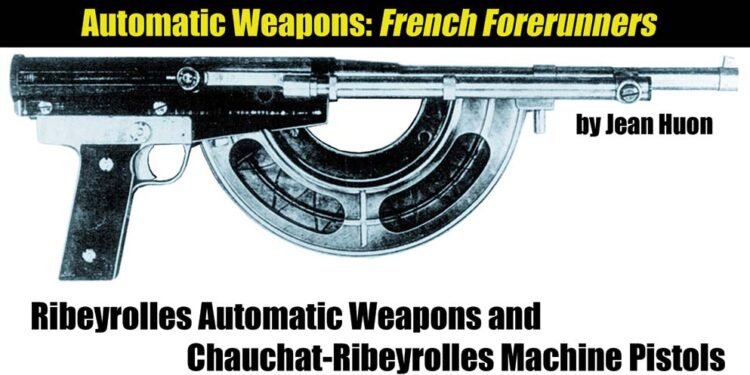By Jean Huon
The term “machine pistol” appeared for the first time in July 1918, with a new weapon presented to a learned assembly of Allied officers. It was developed for tanks crews and it is undoubtedly the first ever Firing Port Weapon. Its mechanism is based on the principle of the M1917 semiautomatic rifle and the first tests took place with a weapon using a special clip of the Mannlicher-Berthier type but with eight cartridges. The experimentation was continued with a Chauchat M1915 light machine gun magazine. All these weapons had in common point that they were created by the same technicians: Chauchat, Sutter and Ribeyrolles.

The experimentation was conducted between summer 1918 and July 1919. The operation appeared satisfactory but the weapon was too powerful for the purpose: closer in protection for tanks crews, it became the weapon of the Renault FT 17 tank driver. The weapon had no stock. The upper part of the receiver was tubular, the lower part was square. The ejection port was on the right, and a pistol grip was located under the frame. The gun is short and the gas cylinder is located on the right side of the barrel, the same side as the cocking handle. The initial model had a large muzzle brake at the muzzle. This model is entirely made of metal parts, except for the pistol grip stocks.
A safety lever is located on the left face of the frame as on the M1917 rifle. It had no selector switch and was fired in the full automatic mode only. The rear sight is that of an American Springfield M1903 rifle and the front sight is a blade on the muzzle brake of the first model. There is no rear sight and only one small front sight on the second prototype. Sights were not needed on this type of weapon as fire was directed through the use of tracer ammunition.
This model works with gas action. The bolt is locked by a rotating head with six lugs.
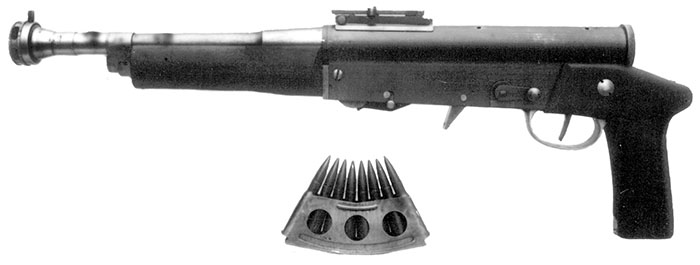
Chauchat-Ribeyrolles Machine Pistol
Caliber: 8 mm
Ammunition: 8 mm Lebel
Overall length: 0.575 m (22.64 in.)
Barrel length: 0.340 m (13.39 in.)
Weight: 4 kg (8.83 lbs)
Magazine capacity: 20 rounds
Cyclic rate of fire: Unknown

Ribeyrolles Assault Rifle
This light assault rifle was produced by the Gladiator bicycle factory. It is an individual weapon firing a special cartridge specially developed for it: the 8mm Ribeyrolles. It is probably the first intermediate cartridge designed for an assault rifle, consisting of a .351 Winchester Self Loading case necked down to 8mm (.31) and loaded with an 8mm Lebel armour piercing bullet. The weapon was designed by one of the inventors of the M1915 light machine gun. It was presented at Versailles proving ground the first time on July 6, 1918. It was tested more thoroughly between July 20 and August 18, 1921 at the Camp de Chalons. The trials did not give good results; the mechanism was unreliable and the ballistics of the ammunition did not give the desired results. Many malfunctions occurred and the accuracy was poor beyond 400 meters (440 yards). It was thus not possible to continue its development because its weight was excessive for an individual weapon and it was not effective as a light machine gun.

The idea of an intermediate cartridge was, however, interesting and it was twenty more years before that subject could be revisited. The Ribeyrolles automatic rifle looked like a small carbine, several of its characteristics reappeared in the experimental 9mm STA 1924 submachine gun. The one piece pistol grip stock was made of wood. Metal elements were of machined steel. The cylindrical frame is closed by a plug, as the barrel is mounted at the front. The cocking lever and ejection port are on the right. The bolt is made of two parts and it has a small diameter recoil spring with a guide mounted rod in a tube. The barrel is covered by a shield; to which are mounted the lower and upper bands, (they are those of Lebel or M1916 rifles). The weapon has a folding bipod, which is made from tube stock. A selector is located on the right of the stock, just over the trigger guard. The front position is for full auto and the rear single shot. Moving it up puts the weapon on safe. The front sight is a blade located at the end of the barrel and the rear sight is graduated from 200 to 2,000 meters (in increments of 200 m). Feed is by a curved box magazine holding 25 cartridges. The weapon works by gas action, the firing pin is independent and actuated by a cam, which works after closing (like some submachine guns of the 1930s). It receives the M 1886-15 or M1915 sword bayonet with 520 mm (20.47 in.) cross section blade and a blued scabbard.
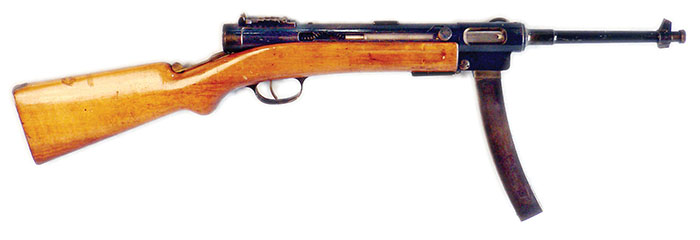
Ribeyrolles M 1918 Assault Rifle
Caliber: 8 mm
Ammunition: 8 x 32 SR
Overall length: 1.090 m (42.91 in.)
Length of gun: 0.450 m (17.72 on.)
Weight: 5.100 kg (11.25 lbs)
Mag capacity 25 rounds
Cyclic rate: Unknown
Although the Russian Fedorov automatic rifle appeared just before the Ribeyrolles, it shot a full power cartridge. The Ribeyrolles is indisputably the first assault rifle of the world using an intermediate cartridge.
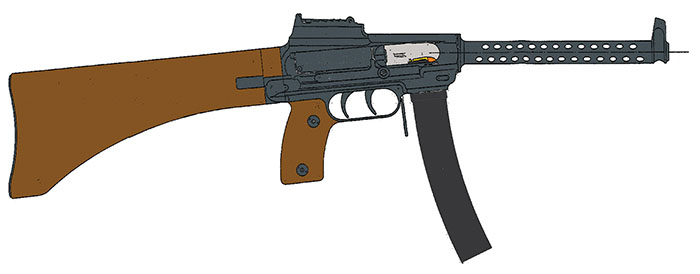
Submachine Guns:
The 1921 Program
The program of 1921 also included submachine guns. The specifications provided that the weapon used the 9mm Luger cartridge. Several models were presented:
- CEI No. 1 and No. 2;
- STA 1922 and 1924, 300 specimens were manufactured, they were sent to Morocco and used successfully during the Rif war;
- MAS Type 1, 1bis, 2 and 3 developed in 1924. These models were the forerunners of the MAS 1938, with a frame mounted a shutter covering the ejection port. The bolt is not exactly in the axis of barrel and a perforated jacket surrounds the barrel. It had two triggers. It shot the 9mm Luger round.
Despite the qualities of these models, the tests were called into question by the choice of a new ammunition: 7.65mm Long, which is nothing other than the American .30 Pedersen round. The tests continued (slowly and without enthusiasm) until 1940, with the adoption on May 9, 1940 of the MAS S.E. 1935; its new designation was MAS 1938.
As a result of this late decision, submachine guns were almost absent during 1939-1940. Special forces and other troops that were normally using them had no other choice than to use experimental weapons, submachine guns returned by the Spanish Republicans or scarce Thompsons ordered in haste.
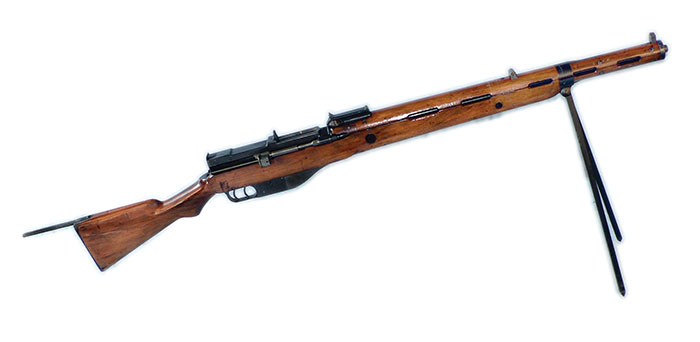
Light Machine Guns
ENT
A program of January 17, 1899, required the development of a machine gun likely to be used under conditions similar to those of rifle and to be operated by two men. In1900, the Ecole Nationale de Tir (ENT or National Shooting School) produced a 6mm (.236) B1 model. It was provided with an articulated butt plate, a wooden handguard that acted as a cooling jacket with lateral ventilation grooves and also with a folding bipod under the barrel. The sight is graduated from 200 to 2,000 m. The firing device has two triggers, one for single shots and the other for full auto. The gun works with direct gas action on the bolt carrier (Rossignol system) and there were two variations of. The B 1:
- one with only one gas tube ;
- the other with two symmetrical tubes, located on both sides of the mechanism. These guns are fed by a vertical box magazine introduced under the bolt (capacity and shape unknown, the boxes were missing on the two specimens examined).
APX
The Atelier de Puteaux (Puteaux Workshop close to south of Paris), made several prototypes between 1903 and 1908. They were created by Jacques Louis Henri Chauchat (1863-1917), armament engineer from the Polytechnique school and by Charles Sutter, administration officer and weapons controller of Puteaux. In 1911, they proposed a light machine gun designated C 7, functioning by long recoil of the barrel and using the 8mm Lebel cartridge. The weapon had an aluminum stock, a perforated jacket around the barrel and was fed by a curved magazine located on the top. After two trials in November 1911 and April 1912, this model revealed some imperfections that were then eliminated. New prototypes were built by MAS and tested in February 1913. They were very reliable (2,500 cartridges fired without incident), and the conclusion was that they could be used by fortress troops or aircraft, but it seems that their use by infantry was not considered. MAS built 188 CS 1913 light machine guns and 65 of them were used by French aviation at the beginning of WW I.
Hotchkiss 1908
The Hotchkiss company had developed in 1907 a lightened version of its machine-gun and was provided with a stock and a bipod. This weapon works by gas action and has a regulator, but the bolt is provided with a rotary head instead of the ascending bolt used on the other model. It is feed from the right side. The sight is graduated from 100 to 2,000 m.
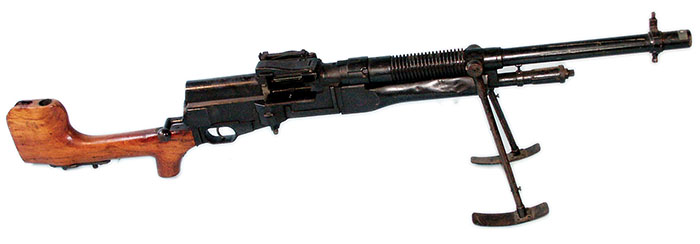
Tested in 1908 (16 specimens bought for tests), this model revealed imperfections which the manufacturer corrected. On December 4, 1911, the Hotchkiss Company received an order for one hundred portable machine guns for tests to take place the following year at the Ecole Nationale de Tir in Chalons. The order was confirmed in April 1912, but these weapons were not delivered until 1913 and 1914. Finally, the weapon was adopted but received only limited use on aircraft.
Hotchkiss Model 1908
Caliber: 8mm
Ammunition: 8mm Lebel
Overall length: 1,190 m (46.95 in.)
Barrel length: 0.600 m (23.62″)
Weight: 12.5 kg (27.59 lbs)
Cyclic rate of fire: 500 rpm
The Hotchkiss light machine gun was also adopted by:
- Belgium for cyclists troops (7.65×53);
- United States under the name of Benet-Mercié Model 1909. Twenty-nine specimens were bought in France and 1,070 others manufactured under license by Colt and Springfield Armory (.30-06).
- Great Britain, as machine gun Hotchkiss Mark I, which was also produced under license at Coventry. It was used by cavalry, aviation and tanks (.303 British).
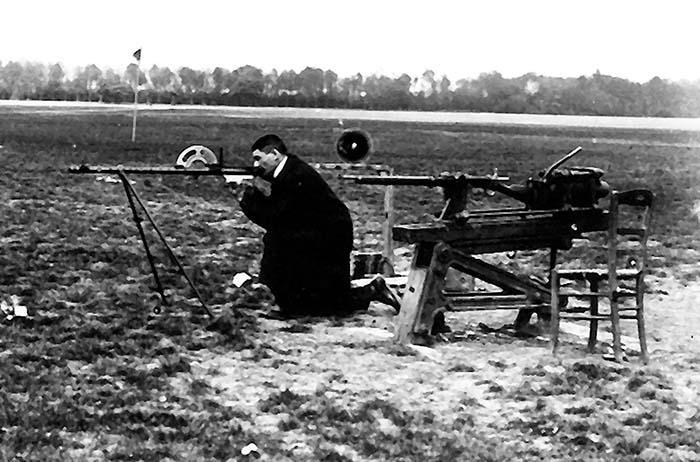
Chauchat
These light machine guns existed before the opening of hostilities in 1914, but Army headquarters did not realize the advantage that it offered for troops.
At the beginning of the conflict, General Joffre demanded the adoption of a very mobile weapon to equip the infantry. He asked that fifty thousand guns be produced as soon as possible. Chauchat and Sutter then modified the weapon which they had designed for aviation and created the first light machine gun of the French infantry. The government arsenals were already operating at full capacity, so its production was entrusted to private industry:
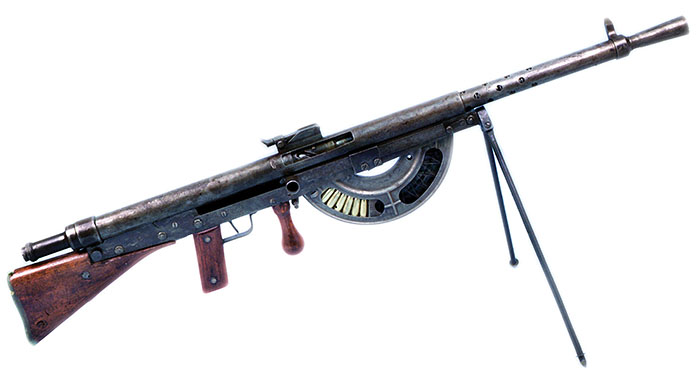
- the Société des Cycles Clément et Gladiator, in Le Pre-Saint-Gervais, close to north-east Paris produced 227,190 8mm M1915 guns, and 20,754 in .30-06 for the U.S. Army;
- Sidarme in Saint Chamont (near Saint-Etienne) produced for its part 20,195 8mm weapons.
The fusil-mitrailleur C.S.R.G was adopted in 1915. In spite of its qualities (simplicity, ease and inexpensive manufacture), the Chauchat light machine gun lacked reliability. The malfunctions were mainly due to the conical profile of the cartridge and its rim which fit poorly in a magazine.
The light machine gun Browning BAR M1918 had made strong impression on the French. So much so that on October 16, 1918, the War Ministry asked the U.S. government to deliver 5,000 BARs each month with delivery to begin in January 1919. Four days later, general Pétain cancelled the order stating that, “The Browning light machine gun does not offer any superiority compared to the Chauchat.” All the plans established to manufacture the .30-06 cartridge in French arsenals were also cancelled.
Berthier and the M1924
Light Machine Guns
In May 1920, general Duval, who was in charge of the infantry armament program declared that it now became essential to consider the manufacture of the BAR light machine gun and its special cartridges. On May 11, 1921, a new program of armament was established and it included the creation of a portable machine gun as a priority. Various types of weapons were put to the test (Lewis 1920, Madsen, Hotchkiss 1922) and license of the BAR was again considered, but Colt and Browning required that France pay $2,000,000 for the licence or order one thousand guns in U.S.A. for the six next years to get the licence free. This condition resulted in the project being cancelled.

Other tests were conducted with the Berthier light machine gun now owned by Vickers. One hundred Berthiers were built by MAC, and while the gun was improved, it was not adopted. Finally, the model selected was that developed at Châtellerault by colonel Reibel. He borrowed many favourable characteristics of the Berthier. This manner of proceeding was completely characteristic of the practices of the French military engineers of the time. They thus claimed to save much payment of royalties to private companies, without worrying about the expenses of studies, nor of the production costs in the arsenals. At the same time, the Saint-Etienne factory developed a MAS 1922 light machine gun, a faithful copy of the BAR…
Machine Guns
Hotchkiss
The French Army tried out various models of automatic machine-guns at the end of the 19th century:
- Maxim between 1887 and 1899;
- Colt in 1898 (potato digger);
- Hotchkiss (1898).
At the same time, the Puteaux Works in 1895 built a copy of the Gatling chambered for the 8mm Lebel cartridge.
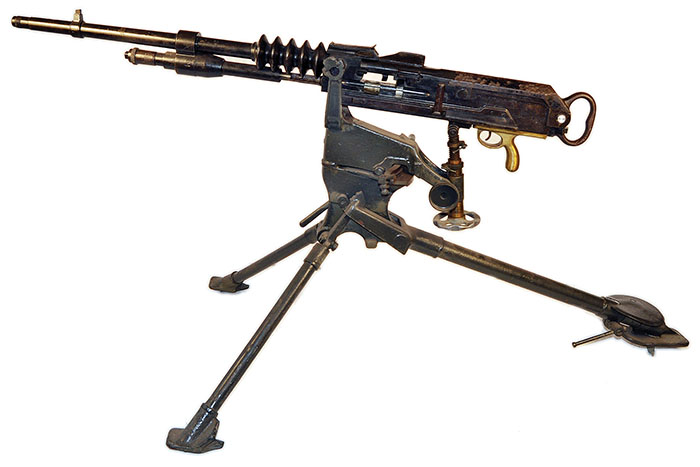
The Hotchkiss machine gun gave excellent results, but improvements were required. In 1900, a new Hotchkiss was brought into partial service in some units for tests (in the East of France and in North Africa). The Hotchkiss Model 1900 differs from the Model 1897 by a barrel provided with a steel radiator (the precedent was out of bronze) and by a new tripod. Between 1900 and 1914, 200 Hotchkiss M1900 machine guns were furnished to the Army. Although the test of the Hotchkiss machine gun was conclusive, the Army still chooses to wait before making a decision in favor of this weapon. This did not prevent its manufacturer from selling the machine gun to many others countries.
The hesitations concerning the adoption of the Hotchkiss machine gun seems to be motivated by research going on at Puteaux Works to develop an equivalent weapon. Between 1903 and 1906, the Versailles Proving Ground examined several machine guns developed by APX. During these tests, many malfunctions were noted. The machine gun was then modified by MAS. Although being far from being the equivalent of the Hotchkiss machine gun, it was adopted in 1909. A little later an improved model, the M1907 T was realized and its manufacture continued until 1917. The modifications relate to sights, installation of a gas regulator and the striker
. At the beginning of WWI, the Hotchkiss company received a sizeable order for machine guns. These weapons, whose reliability in combat appears greater than the Saint-Etienne M1907 T did not see general use in the front until 1916. The Hotchkiss Model 1914 is similar to the model 1900 in concept but a large number of its components had been improved (mounting of the barrel, the gas piston, the feed mechanism, etc.), while the stock and optional safety were removed. The gun was manufactured at Saint-Denis (near Paris) and later in Lyon, in the Hotchkiss factories. Between 1914 and 1918, 45,850 were made for the French Army and 23,700 for the Allies.
For lack of a replacement weapon, the Hotchkiss M1914 machine gun was still in service in 1939-40 in the infantry, used as a secondary weapon through 1944-45 and later in Indochina and Algeria.
Darne
The Darne company was one of the best known gun producers of Saint-Etienne. Created in 1881, it is famous for its fixed shotgun, provided with a sliding bolt actuated by a lever.
During WWI, Darne received an order to produce Lewis machine guns for the French Air Force and made 3,266 guns. In 1916, Darne, father and son, developed a machine gun of their own design. Some specimens were delivered to the French Army in 1917 and in August 1918, the Darne establishment received a large order for 8mm machine guns. The armistice of November 11, 1918 caused the cancellation of this contract, but the Darne Company was invited to continue the development of its machine guns in order to improve their performances. Darne then created a “Military Division” which proposed a true system of weapons:

- light machine gun with box-magazine;
- light machine gun fed by link;
- infantry machine gun on tripod;
- tank machine gun;
- aircraft machine gun synchronized to shoot through the propeller, with a cyclic rate of 1,000 to 1,350 rpm. The links belt can be introduced through the right or left side;
- a heavy caliber machine gun, which can be produced in a normal or synchronized version.
These machine-guns have a square frame carrying the cocking lever on the right or on the left. This frame contains the carrier and the bolt, recoil spring and the feeding device. The barrel is easy to change and is connected by a band to the gas cylinder, usually placed below the barrel.
The number of parts is reduced to a minimum with large-scale use of manufactured goods (tubes, rods, profiled) or sheet metal parts.

It functions by gas pressure. It is locked by a tilting bolt, the rear part of which moves upwards to lock. The striker is located on the bolt carrier and it passes through the bolt after closure. The round will no be fired if the bolt is not locked upon closure.
The aircraft version was very successful and used by several countries, such as Brazil, Czechoslovakia, France, Great Britain, Germany, Italy, Lithuania, Serbia, Spain, Turkey.
Other Machine Guns
A heavier variation of the Chatellerault light machine gun was used for tank and fortress: the MAC 31. Other projects to develop a new infantry machine gun started at the beginning of the 1930s. Several prototypes were developed both by MAC and MAS, including 7.5mm guns but also other heavier caliber including 8, 9, 10, 11, 12 and 13.5mm guns.
Aircraft machine guns, the MAC 34 (derived from the MAC 31) was realized, but they were not the best. Two variations do exist: MAC 34 T for turret and MAC 34 A for wing – both fed by a drum. Other variations were fed by links and the MAC 34-39 was belatedly realized. Nevertheless, a few days before the war, it was necessary to buy from abroad the excellent Browning machine gun manufactured by Colt and FN.
After this survey, we must note that if the French technicians showed competence, the military officials or politicians (in the time period considered) showed very little.
| This article first appeared in Small Arms Review V17N3 (September 2013) |



